The focus of my Social Justice ePortfolio is to examine the offerings of the Clifton Public Library located in Clifton, New Jersey and how they serve the Immigrant Population in their community. This page will focus the progress I have made on my research.
*ALL TEXT IN BLUE ARE HYPERLINKS
Explain the Social Justice Project
I had initially planned on having the library start some kind of program that was geared towards helping immigrants within the City of Clifton, New Jersey. That however, did not work out as planned. I was able to show that there is a need for more programming and resources for this specific population but a program unfortunately did not come to fruition. Who would this project benefit? This project is geared towards helping the immigrant and New American population that lives in the City of Clifton. According to a survey conducted in 2019 by the Migration Policy Institute, 25% of the New Jersey population has less than 5 years of citizenship (Migration, 2019). I conducted a survey of patron requests during a one month period and found that most people in the community wanted some form of ESL and Citizenship classes available within the library. This shed some light on the current needs of the community and how the Clifton Public Library was not addressing them. I believe that such programs can change the way the community uses the library. I also surveyed several staff members as well. They responded to several questions on how to better help our patrons. At the beginning of the semester I was very excited because it seemed like I would be getting more support from the library to address patron requests within the immigrant community. That turned out not to be the case and requests still come daily for programming and resources geared towards the Hispanic and Immigrant population.
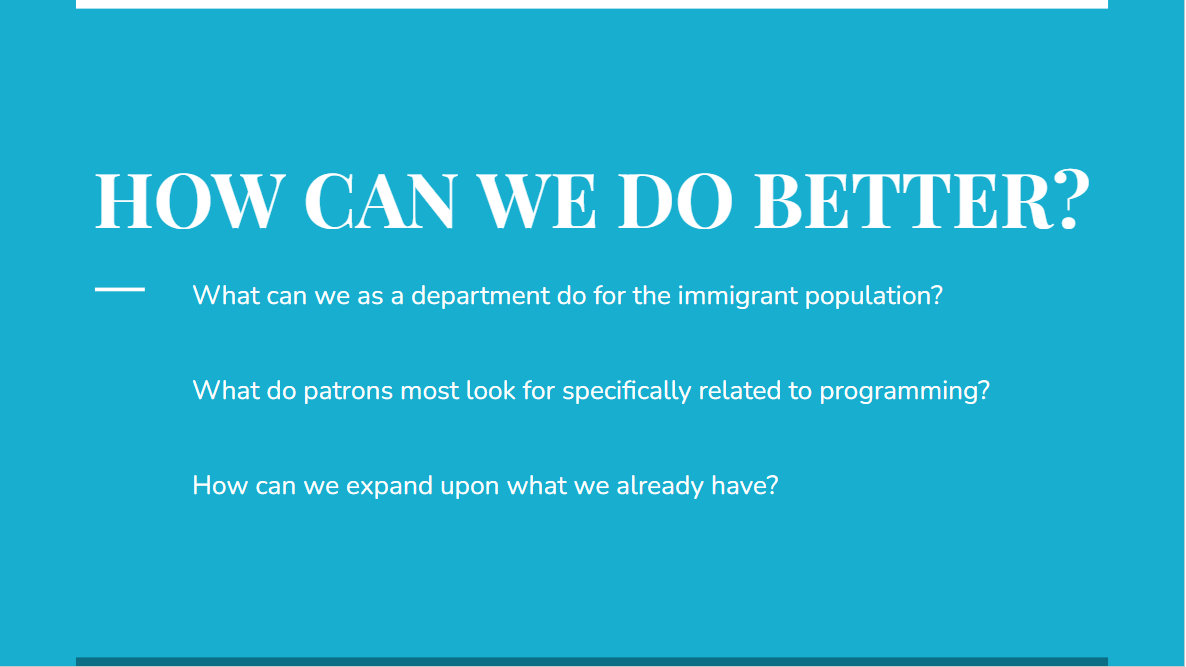

Assess/ Evaluate The Social Justice Project
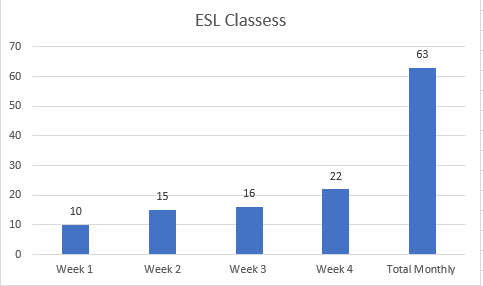
FIGURE 1
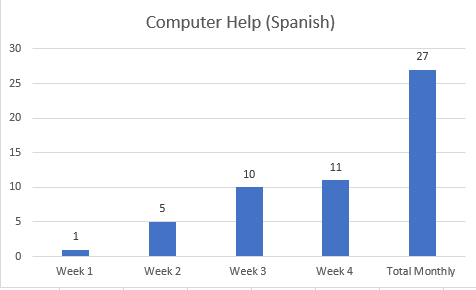
FIGURE 2
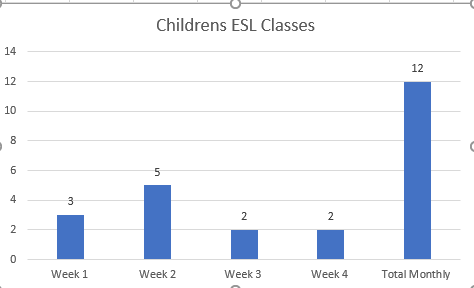
FIGURE 3
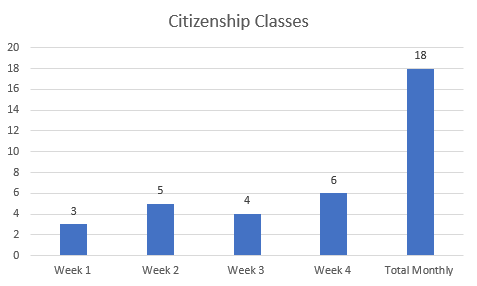
FIGURE 4
Figures 1 through 4 above explain the outcomes of my research into patron needs. I kept track of every patron question that pertained to program offerings that would be beneficial to the immigrant community. For one month I kept track of all of the program inquiries that fell into four categories, esl classes, computer help, children's esl classes and citizenship classes. The category with the most interest has been ESL classes with an average of 63 people asking on a particular month. One challenge that I faced in gathering this information was getting the staff to report the data back to me. Since I am not at the front desk all of the time I had to rely on others to help gather the information. A weakness of collecting data this way is that it does not go in depth enough as far as gathering information. I had to keep the questions simple and not go into too much detail with patrons as I was not allowed. What did work in this project was the fact that this data did show that there was an interest in these kinds of programs. That however, is a challenge with this type of work environment. You can't always ask the questions you want to and gather the kind of information that would really create change for the library. There has always been immigrants using the library but the number of immigrants using library services has increased over time (Burke, 2008). We need to make sure that we reach as many as we can and hopefully this research will help that goal.
THEMATIC CATEGORIZATION
Two themes emerged from my experience in this social justice project. One theme was equality. While the library itself is supposed to be a space that is open and available to all, for the immigrant population within the city of Clifton I do not think that this is the case. A couple of years ago we were headed in the right direction. We provided ESL classes and had programming geared towards the immigrant population. After covid happened everything changed. We stopped providing ESL classes and we do not provide any services or programming for the immigrant population. Despite the fact that it is clearly written in the library strategic plan that we will provide such services. Native English speakers and non-immigrants are offered plenty as far as programs and accessible information. Why should the immigrant population be left behind? Another theme that came up during this project was equality. I feel like my library institution does not provide enough programming equally to all community populations. "There is a need to advance U.S.- based LIS education so that new library professionals are aware of the sociopolitical implications of engagement with immigrant communities" (Ana 2020). If librarians make themselves more aware of community needs we can be of better service.
Vision Statement, Mission Statement and Service Priorities
Clifton Public Library ( Clifton, NJ)
"SO WHAT"
1. Strategic Action Plan
REVISED MISSION STATEMENT
The Clifton Public Library currently has a mission statement available. A strategic plan is available on their website. However, it does not focus enough on the needs of the immigrant population located in Clifton. Going forward a strategic plan and goal that focuses on more community evolvement and diversity in programming for Non- English speakers and the immigrant population would be beneficial. Below is an example of what I would want the library mission statement to look like.
"Our Mission as a library is to provide a safe and welcoming space to all our community members. We strive to offer inclusive and diverse programming and resources that will benefit our diverse population which includes our immigrant and ESL speaking community. "
REVISED STRATEGIC PLAN
A strategic plan is also a very valuable resource for libraries. The Clifton Public Library currently has a strategic plan.
A. Offer more diverse programming that focuses on the immigrant population that includes citizenship classes
B. Establish regular programming for citizenship seekers by 2024
C. Create strong bonds and relationships with community leaders
D. Make sure that we fulfil the goals written in the existing strategic plan
Implementing the above strategic plan would bring about a lot of positive change for the library and the community at large. It is obvious that these are the types of programs and resources that the community is asking for. All we have to do is deliver and give them what they need.
2. Projections
I would love to say that I project that the library would step up and implement all of the suggestions in my project but I do not think that would be the case. I recently learned that such a project was introduced to the library director years ago via a donation from a generous patron. The community member donated money to the library with the goal of the library using that money to create programming geared towards immigrants and the Hispanic population. This started in 2018 and since then only 2 programs have occurred. I recommend that the Clifton Public Library really starts listening to patron needs and realizes what a positive impact programs geared toward the immigrant and non-English speaking population would have. The ways that one’s language is preferred and promoted in public domains impact the perceptions of children and their parents about the desirability of their heritage language ( Kim, 2023). Library workers can make a difference if we make a conscious effort to make our libraries spaces of inclusion and equality.
SOURCES
1. Ana Ndumu and Michele Villagran. "New Ways of Teaching Library Service to Immigrant Communities" Association for Library and Information Science Education: ALISE 2020 Conference Proceedings (2020).
2. Burke, S. K. (2008). Use of Public Libraries by Immigrants. Reference & User Services Quarterly, 48(2), 164–174. http://www.jstor.org/stable/20865036
3. Kim, Yahnghee; Kim, Hyun Chu Leah; Kim, Junye. (July 2023). Korean immigrants’ perceptions of library services and library multicultural programs for Asian communities before and during COVID-19. Sec. Language, Culture and Diversity. Volume 8 - 2023 | https://doi.org/10.3389/feduc.2023.1081143
4. Migration Policy Institute.(2019). Profile of the Unauthorized Population: New Jersey. https://www.migrationpolicy.org/data/unauthorized-immigrant-population/state/NJ